
Fishes of the fourth order with large scales on the head and gill-covers, which are smooth edged and unarmed; with a body very long in proportion to its thickness, and little compressed; with one long unarmed fin on the back; and with two ventral fins.
This genus of Indian fishes, first noticed by Bloch, contains a considerable number of species, all having a very strong affinity to each other, and rather difficult to distinguish by satisfactory characters, owing, in a great measure, to the number of rays in the fins being liable to a considerable variation in different individuals of the same species. The colours also vary considerably at different ages, and, I suspect, in different circumstances affecting variously the animal's health, although on this last point I cannot be certain.
All of them, that I know, afford a light and wholesome but rather insipid diet, and are very tenacious of life. In so much, that in China they are often carried alive in pails of water, and slices are cut for sale as wanted, the fish selling dear while it retains life, while what remains after death is considered as of little value.
Besides the characters mentioned as generic, all those fishes, although their colours are variegated and sometimes bright, have a lurid appearance. They have the head rounded before, and flattened towards the jaws; and it is short in proportion to the body. The mouth is large, and descends backward, the under jaw being the longest. The lips are fleshy, with a small bone belonging to each side of the upper. In both jaws are many small teeth crowded together, with some large sharp conical ones intermixed in certain places. The tongue is smooth, and not tied down. Each nostril has two apertures; one tubular near the jaw, and the other circular near the eye. The eye are of moderate size, and placed at a distance from each other, but rather high. The gill-covers move freely, and leave a large aperture . Their membranes cover the throat, and are there half exposed to view. They are thick; but, although the rays are concealed by the covers, these do not prevent the number of rays which they contain from being ascertained.
The body is slippery. When there are lateral lines they commence on the shoulders, suddenly bend down behind the pectoral fins, and from thence run along the tail in the middle of its depth. Some of the species, however, have no lateral lines.
There are seven fins , of which the dorsal extends from the head to near the end of the tail, and that behind the vent extends from this organ as far as the dorsal does. Both are very high, and their rays are of nearly equal lengths, but rather longer behind than before. The pectorals , which are low down, and the tail fin, are rounded. The former are shorter than the head, and the ventral fins, which are near each other, are still smaller.
An ophiocephalus with from forty-three to forty-six rays in the dorsal fin; with many irregular black belts surrounding the body; and with the hinder parts of the back and anal fins spotted with black.
Although La Cepede (Hist. des Poissons, Tome III. p. 552) would seem to know this genus merely from the writings of Bloch, yet his description of the colours of the wrahl can by no means be reconciled with that given by Bloch ( Ichth. Tome X. p. 117, Pl. CCCLIX) of his O. striatus, which La Cepede considers as the same with his wrahl . This is a most barbarous name, which, were the two species the same, should, on every account, be rejected for the classical name given by Bloch; but there is reason to believe that the fishes of the two authors are different; for that of Bloch, which I have never seen, has the back of an uniform dusky colour, which, on the sides, is irregularly indented with the white of the belly; while the back and vent fins are obliquely striped, throughout their whole extent, with broad dusky lines. I doubt much of the name wrahl being Malay, as La Cepede states, because the missionary John, by whom this name was transmitted to Europe, so far as I know, had no knowledge of the countries where the Malay language prevails; nor has the word any resemblance to the soft sounds of that tongue. After the word wrahl, or what was read as such, John probably put the letters Mal. intended as a contraction for Malabar, the vulgar name by which the Tamul language is called by the Europeans in India. His European correspondents, not aware of this, have probably considered the letters Mal. as a contraction of Malay. I must, however, confess, that, in the dialects of the Tamul, which I heard, as well as in the Bengalese, the fish is called Sola , or Sol ; and Wrahl is probably an erroneous reading of what John wrote.
The wrahl , or sol , is found in the ponds and rivers, both fresh and salt, of every part of India that I have visited, and grows to about two feet in length . Its upper parts are of a brownish-green colour , variegated with irregular black belts. Below the lateral lines, the sides are variegated with dark and yellow belts, and the belly is white. The hinder extremities of the vent and back fins are yellowish, with many black spots between the rays.
 | Plate XXXI, fig.17 (i): Drawing of O. wrahl in adult state. The today's valid scientific name is Channa striata. |
The head is broader than the body, with large angular scales, on which are, irregularly scattered, several small circular cavities. On the lower part of the head are scattered many dots, collected into irregular clusters. The upper jaw has a notch at the end, and is protruded, when the mouth opens; both have a membranous veil, as it were, on their inside. The teeth are imbricated in a double row in each jaw, with many large conical ones intermixed. There are folds on the palate . The gillcovers end in a point, and each of their membranes contains six rays.
The lateral lines are plainly distinguishable. The vent is rather behind the middle. The scales on the body are imbricated, orbicular, large, and smooth on the edge, but rather rough on the surface.
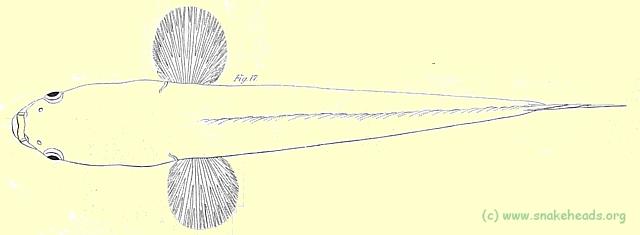 | Plate XXXI, fig. 17 (ii): Schematic top view of O. wrahl |
The rays of the back fin are all jointed: the foremost are undivided, but nine or ten behind are branched. Each pectoral fin contains seventeen dichotomous rays. Each ventral fin contains six rays. The anal fin contains from twenty-six to twenty-eight rays like those of the back. The tail fin contains fourteen long rays, with some short ones on each side.
An ophiocephalus with from forty-three to forty-six rays in the back fin; with the back of an uniform colour, and with no spots on the back and anal fins.
This is no doubt the Muttah of Dr Russell, (Indian Fishes, Vol. 11. No. 162,) which he considers as the same with the Ophiocephalus striatus of Bloch ; but its colours differ much both from those of that author, and from those of the sol , which by La Cepede is considered as the Ophiocephalus striatus . I should, however, have taken the sol and chena for fishes belonging to the same species, had not the fishermen of Goyalpara, where both are very common, considered them as distinct fishes.
Except in colour the chena differs in nothing essential from the sol ; and, as it has been described by Dr Russell, I need not enter into any farther detail.
An ophiocephalus with about thirty rays in the back fill, and with many dark belts on the back, descending to a longitudinal dark irregular stripe, which passes through the eye to the tail.
Except in colours this fish differs little from the O. punctatus of Bloch, ( Ichth. Tome X. p. 114, Pl. CCCLVIII ) which name La Cepede (Hist. des Poissons, Tome III. p. 554) has most wantonly changed to the barbarous Karrowey , that does not differ from Gorayi , the name given in Bengal to the young fish, while the adult is called Lata . The colour of the fish, as described by La Cepede, being of an uniform dirty white, with many small spots, can neither be reconciled to that of the Lata, nor to that of the O. punctatus of Bloch , which has its back of an uniform black colour; and in the account both of La Cepede and of Bloch the jaws are stated to be of equal lengths, which is not the case in any ophiocephalus that I have seen.
The Lata of Bengal, in the Tamul language, was called Mota by those whom I consulted; but the Muttah of the Telingas, evidently the same name, is referred by Dr Russell to the Ophiocephalus striatus of Bloch , while the O. punctatus of the latter author is referred by Dr Russell to his sowarah , (Indian Fishes, Vol. II. No. 163,) but the tail fin of the sowarah ends in a sharp point, which is by no means the case with that of Bloch , nor with any species of ophiocephalus that I have seen.
Having premised these difficulties, I now proceed to state, that the Lata of Beingal is found in the ponds of all parts of India that I have visited; that, so far as I know, it never exceeds a foot in length ; and that, for eating, it is considered far inferior to the sol.
 | Plate XXXIV, fig.18 (i): Drawing of a O. Lata in juvenile state. |
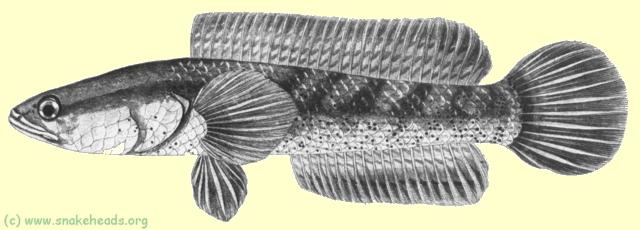 | Plate XXXIV, fig.18 (ii): Drawing of O. Lata in adult state. |
The head is wider than the body, and is covered with large angular scales, on which are irregularly scattered several small round cavities. In opening the mouth the upper jaw is very little protruded, and the bones of the upper lip are minute. In both jaws the fore teeth are crowded and small; the hinder ones are in a row, remote from each other, large, and conical. The tongue is sharp. The palate is smooth behind, but contains many small teeth adjacent to those in the jaw. The eyes are far forward. The gill-covers end in a point, and each of their membranes contains five rays.
 | Plate XXXIV, fig.18 (iii): Schematic top view drawing of O. Lata. |
The lateral lines are with difficulty distinguished from others formed by an elevated line, ending in a raised point, which runs along the centre of most of the scales; but the scales on the true lateral lines end in a notch. The scales are large, adhere firmly, are smooth, and have entire edges. The vent is before the middle.
The back fin is rounded at the posterior end, and its last ray is very deeply divided into two. Each pectoral fin contains sixteen rays, of which one on each side is simple, the others are branched. Each ventral fin contains six rays, of which the first is undivided, and the others are branched. The anal fin is rounded behind, and contains about twenty branched rays: that of the tail contains twelve that are long and distinct, besides some short compacted ones at each side.
An ophiocephalus with from fifty-two to fifty-four rays in the back fin, and six in each ventral, and with an eye-like spot on the fin of the tail.
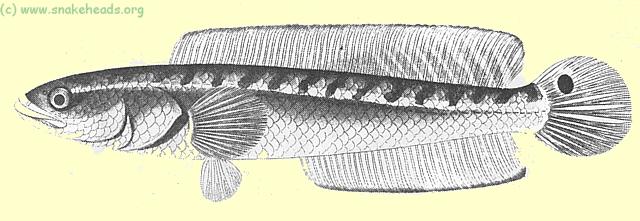 | Plate XXIL, fig.19 (i): drawing of O. marulius in a juvenile state. |
 | Plate XXIL, fig.19 (ii): drawing of O. marulius in a adult state. |
 | Plate XXIL, fig.19 (iii): Schematic top view drawing of O. marulius. |
The lateral lines are evidently distinguishable. The vent is before the middle. The scales on the head are very large and angular: on the body they are of moderate size, smooth, and dotted; and, in general, are marked on the centre by a longitudinal elevated line.
The back fin is rounded behind, and its rays near the fore part are bifid, while those towards the tail are branched. Each pectoral fin contains nineteen rays, of which one on each side is simple, while the intermediate ones are branched. The ventral fins are sharp-pointed, and each contains one short undivided ray, and five branched ones. The anal fin is rounded behind, and contains from thirty-one to thirty-five rays. The rays in the fin of the tail are fifteen in number.
An ophiocephalus with about fifty-two rays in the back fin, and five in each ventral.
This fish I found in the Brahmaputra river, near Goyalpara, where it inhabits perpendicular banks in holes dug like those of the Martin, (Hirundo) . In these it lurks watching for its prey with its head out; and, notwithstanding its strong and variegated colours, is an ugly animal. It is found three feet long, and is considered by the natives as excellent food.
 | Plate XXXV, fig.20 (i): drawing of O. barca in a adult state. |
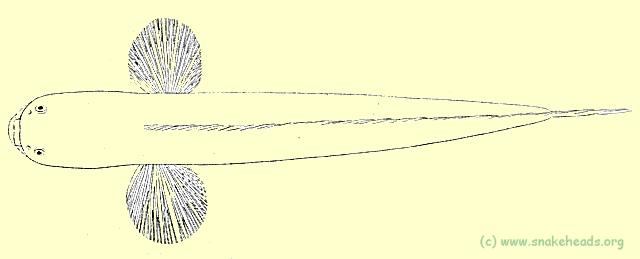 | Plate XXXV, fig.20 (ii): Schematic top view drawing of O. barca. |
There is no distinct lateral line . The vent is before the middle. The scales are large and smooth.
The back fin terminates behind in a sharp point, and all its rays are divided at the end. Each pectoral fin contains sixteen rays, the anal has thirty-five, and that of the tail nineteen.
An ophiocephalus with about thirty-six rays in the fin of the back, and five in each ventral ; and with irregrular dusky belts across the back.
This fish, which sometimes grows to a foot in length, but seldom exceeds a span, is very common in the ponds and ditches of Bengal, and is one of those which are supposed to fall with the rain from heaven. In fact, with the first heavy showers of the season, it has been often seen leaping and wriggling among the grass; and both by natives and many Europeans is supposed to have fallen with the rain. I have, however, no doubt, that the animal, when thus discovered, has been in search of a more commodious abode. During the dry season it has suffered much from being pent up in half putrid stagnant pools, so that, when the first heavy rains fall, it is eager to enjoy the grateful supply of fresh-water, and wriggles among the moist grass in search of more room, and of the food, which must have been nearly exhausted in the pools that it formerly occupied.
The boday above is of a greenish colour , and below of a dirty white. Several dark belts run across the back to the lateral lined, descending obliquely forward. The throat and insertions of the pectoral fins are bluish. The fins of the back and tail are greenish, edged first with black, and then with dirty red. The pectorals are pale brick colour, with several rows of blue spots. The anal fin is of a dirty pale bluish-green, edged with black, and then white.
The head is wider than the body. The upper jaw , in opening, is little, if at all, protruded. The only long teeth are in the fore part of the upper jaw. The tongue is rather sharp. The gums project behind the teeth, nor has the palate any of these organs. The eyes are placed forward. The gill-covers end in a sharpish point, and each of their membranes contains five rays.
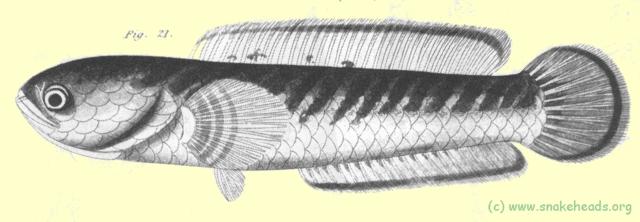 | Plate XXI, fig.21: drawing of O. gachua in a adult state. |
The fin on the back is rounded behind, and its rays at the top are divided into two or more branches. Each of the pectoral fins contains: fifteen divided rays, and each of the ventrals five. The anal fin contains about twenty-two divided at the tops, and that of the tail has about twelve.
An ophiocephalus with about thirty-four rays in the back fin and with the colour of every part of the fish like that of an orange.
This fish I found in a pure mountain stream near Goyalpara on the N. E. frontier of Bengal. The bottom of the torrent consisted of stones. I have put it down as a distinct species with doubt, because the fishermen gave it the same name with the last described species ; and, on a close examination, I could find no essential differences between the two, except in the colours. These indeed, are so different, that I can scarcely persuade myself that they originate entirely in a difference of the situation in which the two animals have lived.
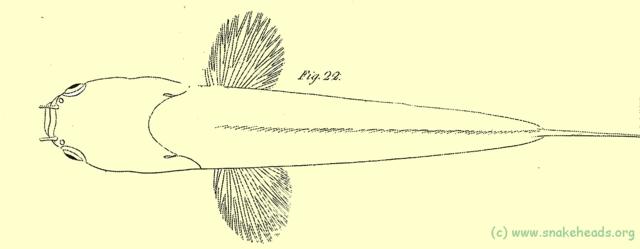 | Plate XXIII, fig. 22: Schematic top view drawing of O. aurantiacus. |
The colours are, however, most widely different, the whole body and fins of the O. aurantiacus being of the colour of orange-peel, with some irregular stains of a redder hue, especially on the sides of the head, and on the pectoral and tail fins.
This section was originally published in: Francis Hamilton (Formerly Buchanan) - An account of the fishes found in the river Ganges and its branches ; two vols. (text, plates). Edinburgh, and London 1822.
© 2001 - 2002 snakeheads.org